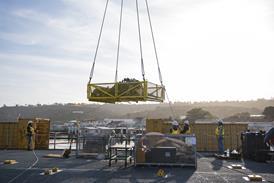Airline maintenance and engineering organisations have struggled, not always with success, to achieve the same kinds of dramatic reengineering improvements enjoyed by other labour and capital-intensive industries such as automotive, steel or mining. Yet this emphasis on hard cost reductions has, at times, almost entirely eclipsed other important ways in which maintenance and engineering functions can save money.
Given that the overall maintenance bill typically takes up between 9% and 13% of an airline's operating costs, the drive for savings is important. But the appropriate measurement and attribution of maintenance costs can also deliver money to the bottom line and is critical to decisions which have a significant impact on overall profitability. To date, few if any carriers have established a procedure for the routine measurement of these costs.
Why measure?Contrary to the popular view, shared by more than a few harried maintenance managers on the ramp or hangar floor, airlines do not measure maintenance costs merely to fuel the acrimonious exchanges and recriminations at the annual round of executive management meetings. Neither do they do it to amuse the underlings in the finance department. In fact, airlines measure maintenance costs in detail for four important reasons.
The first is to comply with regulatory and financial reporting requirements. Most airline maintenance costing has been built around this need and is reasonably good in producing accurate, timely, and representative summaries of cost for accounting or regulatory purposes - the US Department of Transportation's DOT Form 41, for example. Unfortunately, the business applications of these summaries are limited, since they do little more than offer fairly general industry and time-series benchmarking measures.
The second and third reasons for measuring maintenance costs are more interesting since they both affect the boundaries between the airline and its suppliers. The second is to understand productivity trends internally, in economic terms, over time. Shifts in labour and material costs over time can indicate a range of management actions, including the introduction of additional cost controls, capital investment, and work process redesign.
The third reason is to identify and isolate operations for outsourcing, and conversely, operations to be brought back in, as well as opportunities to sell maintenance work profitably to other airlines. Importantly, a thorough understanding of cost can indicate which operations, at what price, with what material support should be outsourced or what type of work can be dealt with inhouse.
The fourth and final reason to measure maintenance costs is because a full understanding of correctly attributed costs can affect strategic decisions. Consider, for instance, the addition of a distant destination to an international carrier's route network. Served three times per week, it looks narrowly profitable with average allocations of maintenance costs. Its actual profitability, however, may hinge on the way that maintenance costs are incurred and reported. Is the line maintenance capability to be performed by another carrier or will the airline put a skeleton staff in place and then try to fill their time by selling their services to other carriers? Will the new station require pre-positioned rotables? What are the chances of an AOG (aircraft on ground), its likely passenger cost impact, and the maintenance cost of resolving it? A rational decision to add, or not to add, the new station may well depend on the airline's ability to provide accurate answers to these questions.
Cost attributionCosting maintenance work is difficult and airlines have struggled for years to produce timely reports that represent costs accurately. The concept of cost representation is important here, since only a fraction of costs within any maintenance activity is directly attributable to any particular operation. For a typical airline, between one fifth and nearly 100% of maintenance costs may actually be allocated, rather than direct, costs.
It is important to understand how costs are incurred. The direct costs include items such as the price of the parts actually installed and the benefits-loaded cost of the time the mechanics expend in installing them. Clearly, these costs are caused by the direct operations with which they are associated. At most airlines other costs are treated as overheads whose allocation is often based on the direct costs. The recent trend towards outsourcing more maintenance activity can be seen in this light since it converts a combination of direct and indirect costs - say for overhauling an engine - into pure direct costs (removing and reinstalling an engine overhauled by a third party provider).
In reality, indirect costs are caused by several factors which, if considered in a way that represents real consumption, can lead from a general allocation method to a more specific attribution. Indirect costs are caused by:
* The existence of the maintenance function (function costs).
* Performing a particular capability internally (capability costs).
* Making a particular service available (availability costs).
For airlines used to thinking of costs along organisational lines - engineering, check line, material support - this is a radical approach. Most subordinate organisations within maintenance and engineering would normally combine costs for several categories. Nonetheless, a change in approach can turn the cost accounting system into a real management tool by indicating the impact of management decisions much more clearly than a traditional system.
To achieve this, the following cost categories and attribution approaches should be adopted:
Direct costsDirect costs are the most readily understood category because they are currently isolated, more or less accurately, in most cost systems. Simply defined, direct costs are those costs (usually, direct labour and materials) which are immediately and exclusively attributable to a particular unit of output. This output is normally one of the core production responsibilities of the unit. Therefore, a mechanic's labour in repairing a piece of avionics equipment is a direct cost, while a planner's labour in scheduling all such pieces of equipment through the shop normally is not.
Function costsThe best way to categorise costs is to think about how you would eliminate them. Function costs remain as long as there is a maintenance and engineering function. They include the head of M&E and his staff, some minimal engineering, planning and quality control, and a bit of infrastructure: a couple of hangar bays, materials support on high-turn items and some line maintenance capacity. Airlines that outsource engines, components, heavy checks, and line maintenance will find that most other costs are function costs.
Capability costsCapability costs are those associated with providing a particular internal service that is part of the normal production of the M&E function. For example, handling landing gear in-house rather than outsourcing requires the existence of a shop, physical assets such as tools and plating baths, and a management and planning capability in its own right. It also causes other costs to be incurred, including additional engineering capacity, additional materials support, chemical disposal costs, a portion of the total finance and administration capability, and so on. These costs go away - are transformed into direct costs - at the point that the airline chooses to outsource the function. To a degree, some may be spread across more units by bringing additional work into the shop.
Capability costs are largely predictable on a tactical as well as a strategic basis. If an airline has an engine shop, it will produce engines. The number of engines it will produce, and the work scopes associated with them, are largely predictable. In this respect, capability costs differ from availability costs.
Availability costsWhereas capability costs are prominent in production settings, such as check lines and component shops, availability costs dominate in the functions that look and behave like fire departments: notably, the emergency response centre and line maintenance. Once everything that can be done to match staff with workload drivers, such as adjusting shifts to flight banks, has been done, airlines don't care how busy line mechanics are, as long as they are available. If the line mechanics at station A turned 20 flights and resolved 30 snags on a particular day, they would not be considered more meaningfully productive than station B mechanics, who turned 20 flights but resolved only 15 snags. Tomorrow, the numbers might reverse but if both stations have the right staff to turn 20 aircraft per day and no more, both operations are optimally efficient. Organisations that function in this way tend to show high proportions of availability costs.
Why use this approach?Expanding traditional direct/indirect cost thinking into the four categories of function, capability, availability and direct costs, requires some other changes: accounting systems aren't set up along similar lines while staff don't think in these terms. And some level of arbitrary allocation is still required within the four categories. However, the benefits in supporting decisions can be considerable.
In this hypothetical example, the overhaul of a particular component costs $1,800 in direct labour and materials. The airline's current practice, based on overall financial performance, is to allocate indirect costs by applying a factor of 0.8 to direct costs. This is not unreasonable, since the split between direct and indirect costs in the maintenance & engineering function overall is 55/45. The result is an internal cost of $3,240, which makes a third party provider offer of $2,800 per unit look pretty good, even with the loss of internal capability.
However, in this case the shop operates with a lot of fully depreciated equipment and few chemicals and other indirect materials. It requires little management and no independent planning capability. For these reasons it generates less than its share of capability costs. A general allocation technique masks the fact that other, more complicated shops contribute proportionally more to the department's indirect costs. Function costs are still essentially an allocation but also make up a small proportion of total costs. The result of this more detailed review of costs indicates that outsourcing this component is a bad idea. Implicitly, the high overall indirect levels suggest that there are higher potential outsourcing targets elsewhere in the airline.
At present the required decision support tools are not broadly available within airlines. However, as maintenance and engineering comes under more pressure to make surgical, rather than general, adjustments to operations based on economic as well as technical considerations, an approach of this nature is likely to be worth the time and effort.
Source: Airline Business























